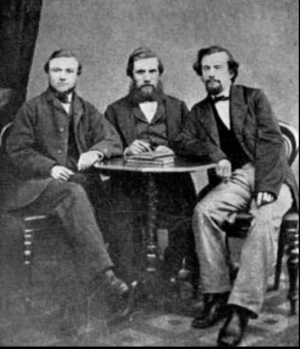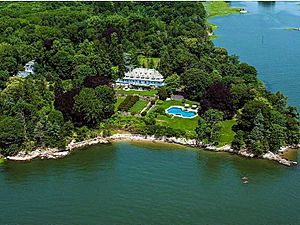George Lauder (industrialist) facts for kids
Quick facts for kids
George Lauder
|
|
|---|---|
 |
|
| Born | November 11, 1837 Dunfermline, Fife, Scotland
|
| Died | August 24, 1924 (aged 86) Greenwich, Connecticut, United States
|
| Resting place | Putnam Cemetery |
| Nationality | Scottish |
| Other names | Dod |
| Alma mater | University of Glasgow |
| Occupation | Industrialist Mechanical Engineer |
| Known for | Revolutionizing the steel industry as a partner at Carnegie Steel and later with U.S. Steel |
| Spouse(s) | Anna Maria Romeyn Varick |
| Children | George Lauder III Harriet Lauder Greenway Elizabeth Storm Lauder |
| Parents |
|
| Family | Lauder Greenway Family |
George Lauder Jr. (born November 11, 1837 – died August 24, 1924) was a very important Scottish businessman. He was a skilled mechanical engineer. George Lauder helped make many big changes in the steel industry during the time of the Industrial Revolution. He improved how steel was made and how coal was cleaned. He also helped use steel to make weapons and defense tools.
Lauder was a close "cousin-brother" and business partner of Andrew Carnegie. Carnegie was a famous steel leader. They worked together in the Carnegie Steel Company. Both men became incredibly rich during their lives. When Carnegie Steel was sold to J. P. Morgan in 1901, it created U.S. Steel. George Lauder was on the board of directors for this new company. U.S. Steel was the first company in the world worth more than $1 billion.
Contents
Early Life and Family
George Lauder was the son of George Lauder, Sr. and Seaton Morrison. His father owned a general store in their hometown of Dunfermline, Scotland. George Sr. was known for supporting Scottish independence and fair democracy. He believed strongly in protecting people's rights.
When George's mother, Seaton, passed away young, his father played a big role in raising both George and his nephew, Andrew Carnegie. George Jr. and Andrew Carnegie were only two years apart in age. They became best friends because they grew up together. As young children, they called each other "Dod" (George) and "Naig" (Andrew).
After Andrew and his family moved to America, George stayed in Scotland. He went to University of Glasgow and earned a degree in mechanical engineering. He even studied with the famous scientist Lord Kelvin.
Building a Steel Empire
In 1873, Andrew Carnegie wrote to George Lauder. Even though George still lived in Scotland, he was Andrew's closest friend and advisor. Andrew asked George about a technical term in a contract for steel needed for the new Eads Bridge in St. Louis, Missouri. George, being an expert, quickly explained the term. This helped Andrew get the contract.
Because of this, Andrew asked George to join him in America. George agreed and moved to Pittsburgh. He joined Andrew, Andrew's brother Thomas M. Carnegie, and Henry Phipps, Jr. in their steel business.
George Lauder brought important new skills to the company. He had a formal education and was an expert in mechanical engineering. None of the other partners had this kind of technical training. George introduced several new ideas to the American steel industry.
One of his first big contributions was a way to clean coal waste. Before George, steel mills just threw away the dirty coal. George designed and built the first machines in the United States to wash coal. This process became a standard way to make steel around the world.
George also led the effort to use steel for armor and weapons. At first, Andrew Carnegie didn't want to get into this business. But President Benjamin Harrison personally asked him to. George Lauder and Charles M. Schwab visited a big factory in Germany called Krupp in 1886. After their visit, they built a huge armor plate mill at the Homestead Steel Works. This changed how warfare was done forever.
By the early 1900s, George Lauder was a director at Carnegie Steel. He managed the coal and ore parts of the business. He was also the second-largest owner of the company, after Andrew Carnegie. After more than 30 years, Lauder was known for giving calm and careful advice. He was often the one who slowed down his impulsive cousin, Andrew. Another partner, Daniel Clemson, even called Lauder a "father figure" to the company.
In 1901, Carnegie Steel Company was sold to J. P. Morgan. This led to the creation of U.S. Steel. George Lauder joined the board of directors for this new company. It was the first company in the world to be worth over $1 billion.
Amazing Inventions
Throughout his career, George Lauder created many new scientific inventions. These were useful in the steel industry and other areas too. His first known invention was approved in 1875. It was for "Improvements in Joints for Wrought-Iron Pipes." He shared this invention with his cousin and partner, Thomas Carnegie. By 1877, his inventions became more technical. He improved batteries and made big advances in folding machines for newspapers and books.
It seems Lauder started focusing on inventions for the steel industry in the 1880s. In 1885, he received a patent for an improvement to the Bessemer process. This process was invented by Henry Bessemer in 1856. Lauder's invention in 1885 made the steel output much more consistent. Before his changes, there were too many steps, which could lead to mistakes. Lauder found a way to remove certain impurities more easily.
In 1887, Lauder improved his coal washing process. He invented a new machine called the "Coal and Ore Jigger." This machine made it even better at getting useful materials from what was once considered waste. This greatly increased the company's income.
Family Life and Legacy
George Lauder married Anna Maria Romeyn Varick in 1877. His wife came from an old Dutch family in New York. Her ancestors included important people who helped create and develop New York City. For example, Joris Jansen Rapelje was one of the first settlers of New Netherland in 1623. He was also part of the first democratic group in what would become the United States. Anna Maria was also related to Richard Varick, who was the second mayor of New York City after the American Revolution.
George and Anna Maria had three children: Harriet, George III, and Elizabeth.
Their daughter Harriet married Dr. James C. Greenway. Their families joined, and they are now known as the Lauder Greenway Family. Together, they gave money to create the Yale School of Public Health. They also bought what became the Lauder Greenway Estate in Greenwich, Connecticut.
Lauder's son, George Lauder III (Harriet's brother), was a famous sailor. In 1900, he set a record for the fastest trip across the Atlantic Ocean with his yacht, Endymion. This record lasted until 1905.
George Lauder's descendants include many notable people. These include explorer James Cowan Greenway, G. Lauder Greenway who led the Metropolitan Opera, and Polly Lauder Tunney who married boxing champion Gene Tunney. Other descendants include U.S. Senator John V. Tunney, war reporter H.D.S. Greenway, and scientist George V. Lauder.
The Lauder Greenway Estate
George Lauder spent the last eleven years of his life as a widower at the Lauder Greenway Estate in Greenwich, Connecticut. This large home was built in 1896 for another businessman, John Hamilton Gourlie. George Lauder's daughter, Harriet, bought it in 1905.
When she bought it, the estate was 57 acres. It had fruit orchards, a chicken farm, a pig farm, and a beautiful French Renaissance style mansion. In the early 1910s, the family added two new sections to the mansion. They also expanded the estate to over 100 acres.
Today, the estate is still considered "Greenwich, Conn.’s last Great Estate." It is a very grand property with 50 acres along the waterfront. It is the largest surviving mansion from the Gilded Age in Connecticut. In 2014, it became the most expensive private home in the United States when it sold for $120 million.



